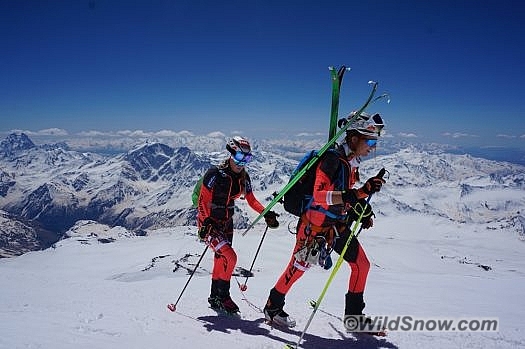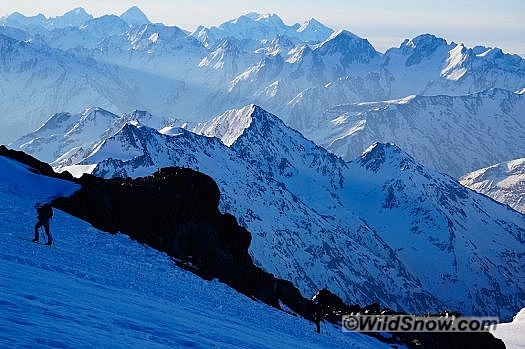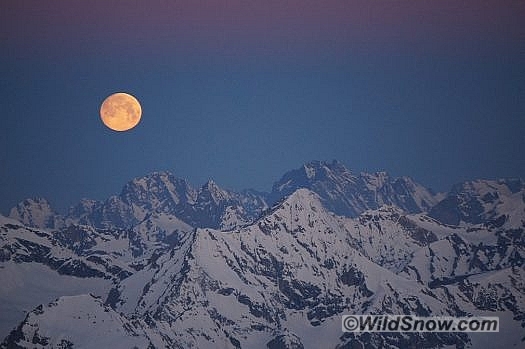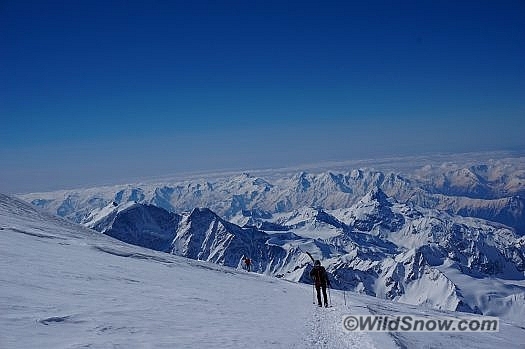Nick Hendrickson

The race is on. Goal: Mt. Elbrus, at 5,642 meters (18,510 feet). All photos by Nick Hendrickson, used by permission. Click to enlarge.
The Red Fox Ski Monsters Race is not just another skimo contest. Reaching the highest peak in Europe, Mt. Elbrus, at 5,642 meters (18,510 feet) is a test of climbing and skiing unlike any other event; it’s more of a “skimo expedition.”
While the Red Fox Elbrus race has hosted sky running races to the top of Mt. Elbrus, they had previously only hosted smaller skimo races on the lower flanks of the Elbrus volcano. 2018 marked the 10 year anniversary of the Red Fox Elbrus Race Festival and organizers spiced up this years race by coming up with a monstrous course that included 50 km distance and 5,000 meters of climbing, with the summit of Elbrus smack dab in the middle of the route. Supported by a hard core group of mostly Russian mountain enthusiasts, Red Fox has created an opportunity for skimo racers to truly test themselves on the highest peak in Europe.
Mt. Elbrus is a dormant volcano with 4,741 meters (15,554 ft) of prominence that packs a punch because of the altitude and historically nasty weather; nasty enough that the name Elbrus is actually derived from the local word, meaning cyclone. Located in the Caucasus Mountains of Russia, just a few kilometers north of the Georgian border, and three hours from the nearest airport, a ski trip to Elbrus is indeed more of a high altitude expedition than a typical skimo race.
Our group of three for the race consisted of myself and two Austrian skimo stars, Veronika Mayerhofer and Johana Erhart. Veronika and Johanna had just finished 2nd in the Sellaronda (March 2018) and 3rd in Patrouille des Glaciers (April 2018), just a week before Elbrus Ski Monsters. Personally, I was registered and actively seeking a partner but unfortunately never found someone willing to join me. Veronika and Johanna however, had been pushing each other throughout the season and this was an opportunity to put it all together for the biggest race of all.
We flew from Munich to Moscow, and onto Mineralye Vody. There, we hitched an adrenaline packed taxi ride three hours to the Azau mountain village. Azau and the neighboring town of Terskol form the hub for all climbers and skiers giving Elbrus a go. Initial impressions of the area were overwhelmingly positive. The people of Azau, the organizers from Red Fox, as well as the fellow skiers and climbers welcomed us immediately. Feeling good after traveling, Veronika, Johanna, and I were soon on skis and skinning up the lower flanks of Elbrus from Azau to acclimatize and get a feeling for the snow conditions.
First day we made our way up to nearly 4,000 meters, all of us feeling the lack of oxygen. It’s hard to fake feeling good when your heart and head are pounding. There is no way to cheat the acclimation process (other than sleeping in a hypoxic tent for weeks or months on end, which is expensive and tedious, though something to consider if you’re thinking of peaks such as Elbrus).
Unusual for Elbrus, calm winds, sun, and clear nights were on tap for the days leading up to the race. However, race day was forecasted for snow, wind, and temperatures of -25 C on top. Our group of three made a decision to try and summit before race day, in case weather the weather didn’t cooperate for race day. We decided to stay at the famous Russian Barrels, located at 3,800 meters, in order to give ourselves a head start for the summit in the morning. We wanted to give the thing a go while we had the weather window; we also had a few days before the race to recover if needed. After all the talk about weather on Elbrus, we knew that we had to attempt it while possible.
Starting from 3,800 meters at four in the morning, we left the headlamps behind and were guided by the full moon for the first few hours. Eventually setting behind the Georgian ridgeline to the south, it was undeniably one of the most beautiful moonsets and sunrises I’ve ever seen. I felt lucky to have a distraction for the first hours of the morning to take photos while disregarding the altitude and the climb ahead. From the barrels, we had more than 1,800 meters of climbing to the summit. To add interest (as if we needed it), not one of us had ever been above 4,500 meters previously. We were all anxious to see how we would react to being so high.
No sugar coating, summiting the first day was strenuous. All three of us went through ups and downs but stayed strong enough to physically just put one foot in front of the other until we made it to the top. Personally, I felt great until 5,000 meters and then would randomly be hit by big gasps of breath I didn’t have control over. I’d never experienced something like it, but taking short breaks helped, and we continued our slog upwards. I do want to note that we had a great dialogue going on how everyone felt and while it wasn’t easy, we all felt safe and strong enough to make it up and back. Nobody said it at the summit, but we were all thinking, “is it really possible to race to the top of this mountain?”
Feeling the altitude and a long day (nearly 6 hours of climbing to summit) we pushed thoughts of future climbs aside, took our skis off, and dropped into the 3,300 meter descent back to Azau. Descending from -20 C on top of Elbrus to +20 C in Azau was possibly the coolest thing I’ve ever done on skis. It really put the size of Elbrus into perspective. It’s a truly massive mountain — and deserves all the respect it gets. With anything but perfect conditions, which we were fortunate to have, I can’t imagine climbing and skiing it.
A couple days of recovery in Azau allowed our team to eat, sleep, and explore the area. Calories and rest were definitely the names of the game the first day after summiting. I personally recommend the savory pancakes filled with cheese and potatoes, followed by a nap. Veronika and Johanna had two days to rest until the race, but I didn’t have to race and was anxious after a day off the mountain. I decided to head up to 5,000 meters with a group of German climbers. First gondola up to 3,800 meters was a late start to go high on the mountain, but I was feeling like a new person after acclimatizing. I let the Germans go their pace while I tried to give another go at the summit. It was a perfect day to summit and I wanted another ski run from the top. Honestly, who wouldn’t?
Summiting and skiing down to the saddle at 5,200 meters, I met two of the German climbers there as they were still on their way up. It was about 13:30 in the afternoon, no clouds in sight and lots of sun. We chatted while we snacked and parted ways with smiles and high fives. The mountain had other plans though, and one of the German climbers became completely exhausted after summiting and making it part way down. He had pushed the limit and his body was shutting down. He couldn’t move his legs anymore and there were thoughts of calling in a helicopter rescue before a Russian climber stepped up to help bring him down to an overnight hut around 4,000 meters.
I (and the rest of our group) of course didn’t find out about the whole situation until the next morning because it’s quite normal for people to go up on the mountain and spend a night at 4,000 to further acclimatize. It’s also difficult to keep everyone’s schedule straight of who is where and doing what. But hearing of the experience hit me hard, even with perfect conditions, the altitude can affect anyone, even experienced mountaineers, and you can quickly find yourself in a really bad situation above 5,000 meters. In the end, everyone was safe and lessons were learned.
With reflection on the past few days, and assessing if we were all ready for race day, the girls and I set up our plan for race day. They would start at 5 am from Azau, with a 1,500 meter climb up to the Barrels. Then a 500 meter descent put them at 3,200 meters followed by a direct climb from there to the summit at 5,642. After summiting, a descent back to nearly 3,000 meters, and then another climb of 500 meters back to the finish. Basically, a whole lot of climbing and descending while at high altitude. It was certainly not an easy day to prep for.
My role was to support the team at the checkpoints as the race progressed. Food, drink, extra clothes, positive encouragement, and of course a lot of photos and film to document the day. Safe to say there was a lot of nervous energy as we packed our bags for race morning; it was bound to be a long day and nobody was quite sure what to expect from such a monstrous endeavor.
RACE DAY
Clear skies and a beautiful sunrise filled Azau with light minutes before the 5 am start of the race. 17 teams of two started with the sound of the gun. A 1,500 meter climb greeted the racers right off the bat, no time for messing around on Elbrus. Veronika and Johanna set off with a manageable pace and came into check point 1 (CP 1) at 6:40, only an hour and 40 minutes to get up the first climb, putting them in fourth place overall. Looking good, they set off down the descent to CP 2 at the waterfall. Once out of view, I started up the mountain, hoping to reach 5,000 meters before they caught me.
I made it farther than I thought in the time given, and waited at the ‘traverse’, between 5,000 and 5,200 meters. I shot photos of racers and the normal groups of climbers alike until the girls reached me around 10:30. Skimo racing at 5,000 meters is a sight to see. Spandex race suits, light weight gear, race bibs; the racers didn’t exactly fit in with the other climbers that were in full down suits and massive mountaineering boots. But once again the mountain was delivering another day of perfect conditions and the racers were able to stay in just their race suits and were warm as long as they continued moving. I hitched a ride with the girls up to CP 7 on the saddle at 5,200 meters.
This was a critical junction because Johanna was going through a low, and the time cut-off to get back to the saddle by 2pm was getting closer. You wouldn’t think that you would need two hours to climb and ski down just under 400 vertical meters; but at that altitude, it’s challenging just to open a Snickers bar. A Red Fox volunteer at the checkpoint was a doctor and had a quick group chat before giving them the green light to go for the summit. Off they went again, with heavy legs but the summit in sight.
The reality of racing that high on Elbrus is that there is moving, and there is resting. There isn’t any extra gear, or digging into the ‘pain cave’ that athletes can find in a typical race. Veronika and Johanna continued to move up without many breaks, and I followed to support to them to the summit. These girls were tough, continuing to show strength and positivity. It was difficult to observe how difficult the summit was, but I know that they were giving it everything they had, and we were all overwhelmed with joy at the top. Red Fox had some amazing photographers near and on the summit that really made the race feel professional and safe if anything were to happen while up there. These volunteers spent nearly ten hours on or near the summit on race day; they’re amazing athletes in their own right and deserve a lot of credit for the time and effort that they put into the race! Hooting and hollering before ripping skins and starting the descent we knew that, just like any mountain, you still had to make it down safe.
Closing in on ten hours of racing, Veronika and Johanna finished the last 500 meter climb, amazingly, with smiles on their faces. Completely exhausted yet happy, they crossed the line and embraced for a long minute, whispering congratulations and thank you’s to each other. I saw multiple people with tears in their eyes simply watching the two girls let their emotions out after such a high intensity day.
After the hug, both girls were horizontal in the snow, skis off, and quickly eating Russian pancakes that a Red Fox volunteer served up. The sun was out and the girls had finished the Red Fox Elbrus Ski Monsters race happy and safe.
A big thank you goes out to Red Fox for organizing the Elbrus Race Festival. Red Fox, a St. Petersburg based company has deep roots in the Russian mountaineering and alpinist community. Originally founded by two Russian alpinists in 1989 to provide themselves and friends with clothing and equipment for the high mountains, Red Fox has been supplying expeditions and outdoor enthusiasts ever since with the highest quality gear.
There are a lot of races in the world, but the Elbrus Ski Monsters Race is uniquely challenging and rewarding, something that any serious skimo racer should put at the top of their bucket list. The race, the mountain, the food, the people, each characteristic of the Elbrus experience compounds on itself to create a remarkable adventure. I hope everyone drawn to the mountains can someday experience this for themselves.
(Growing up in the Wasatch Back of Park City, Utah WildSnow guest blogger Nick Hendrickson competed for the US Ski Team for five years as a nordic combined skier before racing for the University of Utah for two years. He now opts for fatter skis and and is found in the backcountry whenever possible, with some occasional skimo racing because he just can’t kick lycra. Currently living in Innsbruck, Austria, sprechen Deutsch and finding new adventures in the Alps.)
Beyond our regular guest bloggers who have their own profiles, some of our one-timers end up being categorized under this generic profile. Once they do a few posts, we build a category. In any case, we sure appreciate ALL the WildSnow guest bloggers!



